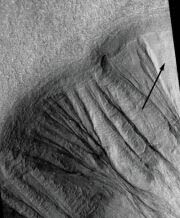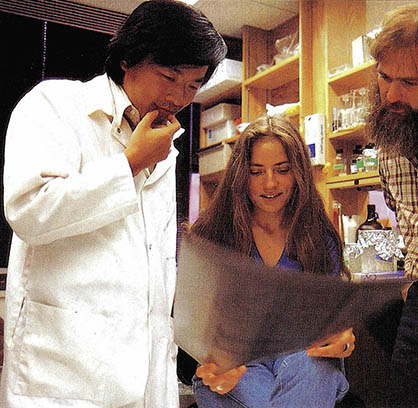우리는 몇 살인가? 여기에서 '우리'란 '현재의 인간', '현대인', '인류' 혹은 호모 사피엔스 사피엔스와 같은 여러가지 명칭으로 알려진 유기체 군(群)을 의미한다. 그 대ekq은 아마도 "우리가 생각했던 것보다 두배는 더 나이가 많을 것"이라는 것이며 이것은 확실한 얘기로 되고있다. 그럼 그 뜻을 알기 위해서, 1856년으로 거슬러 올라가 보자. 서독의 네안데르강(독일어로 네안데르탈)계곡에서, 노동자들이 석회암 동굴을 치우다가 뼈 몇개를 발견하였다. 여기에 특이할만한 것은 아무것도 없었다. 통상 그런 뼈들은 그저 내다 버려졌다. 그 뼈들도 역시 버려졌다. 허나 소문이 근처 한 대학교수의 귀에 들어갔다. 그는 그 장소를 찾아냈으며 14개의 뼈를 구했다. 이 가운데에는 두개골도 있었다. 뼈들은 분명히 인간의 것이었다. 그런데 특히 두개골은 보통 인간의 두개골과는 다른 몇가지 흥미있는 차이점을 보여주었다. 그것은 양눈 위에 튀어나온 뼈를 가지고 있었다. 또 이마는 뒤로 경사졌고, 턱은 쑥 들어갔으며, 이는 심하게 앞으로 튀어나와 있었다. 이 유골은 곧 '네안데르탈인'이라고 불려졌고, 곧이어 시끌법석한 논쟁이 벌어졌다. 그것은 현대인류의 옛 원시 조상의 유골인가, 아니면 약간 불구의 보통 사람의 것인가?
후에, 바로 그같은 두개골을 가진 다른 유골들이 유럽과 중동의 여러 지역에서 발견되었다. 똑같은 뼈 질환을 갖고 있는 사람이 그렇게 많을수는 없다. 그리하여'네안데르탈인'이 초기의 원시적 인간형이었다는 것이 어느정도 받아들여지게 되었다. 인류학자들은 네안데르탈 인을 '호모네안데르탈렌시스'라고 명명하기 시작하였다(현대인은 호모 사피엔스로 불려지는 '사피엔스'란 영리한 혹은 지각력이 있는 이라는 뜻이다). 이 양자는 호모(인류)속에 들어간다.
결국 네안데르탈 인과 현대인의 차이는 아주 작아 보였음에도 불구하고 인류학자들은 그것들을 두가지 변종으로 생각하게 되었다. 네안데르탈 인'호모사피엔스 네안데르탈렌시스'로 현대인은'호모 사피엔스사피엔스'로 불리어졌다.
네안데르탈인은 25만년전의 보다 오래되고 원시적인 조상에서 유래 되었을것 같다. 때와 장소에따라 일부의 네안테르탈인은 현대인의 특성을 갖추기에 필요한 최소한의 진화만을 해왔다. 우리는 네안데르탈이 정확히 언제, 어디서부터 등장하기 시작했는지 알수가 없다. 왜냐하면 네안데르탈인은 숫적으로 대단히 적었고 또 매우 영리해서 화석화될 수 있는 상황을 용케 피했기 때문이다. 그래서 우리가 판단자료로 쓸 화석이 매우 적다. 게다가, 현대인의 뼈와 꼭 같은 고대인의 뼈들이 계속 발견되었다. 그것으로 판단컨대, 현대인은 적어도 4만년전에는 나타났음이 틀림없다. 이것은 아마도 북 아프리카에서 일어났을 것같은데 확실한것은 아니다.
최후의 네안데르탈인의 뼈는 약 3만 5천년이 된 것이다. 그렇다면 잠시동안 현대인과 네안데르탈인이 지구에 같이 있었다는 얘기가 된다(주로 유럽에서, 이 곳에서 네안데르탈인의 화석이 대부분 발견된다).
그래서 네안데르탈인과 현대인은 네안데르탈인이 사라지기 전, 5천년 동안 같이 살았던 것으로 보인다.
아마도 이 두 변종들은 서로 부딪치게 되면, 식량과 거주지를 차지하기 위해 싸웠을 것이고, 여기서 네안데르탈인이 패했을 것이다. 왜일까? 그것은 확실치가 않다. 개인적인 차원에서는 네안데르탈인이 현대인보다 단단하고 더 강했으리라고 생각케하는 몇가지 근거가 있다. 그러나 그들은 상대적으로 덜 영리했던 것 같다.
또는 현대인들이 보다 솜씨가 좋았을 수도 있다. 내가 좋아하는 이론이 있는데 그것은 다음과 같다. 즉 현대인이 투석기나, 활, 화살과 같은 멀리 나가는 무기를 만들었고, 이것을 활용, 원거리에서 네안데르탈인들을 공격함으로써 근접전을 피했다는 것이다. 그래서 가엾은 네안데르탈인들은 거의 모든 싸움에서 패했고 점차 숫적으로 감소하게 되었다. 마침내 수가 늘어난 호모 사피엔스 사피엔스들은 지구의 명실상부한 주인이 되었다.
그러나 일단의 프랑스와 이스라엘 인류학자들이 지난 2월에 제출한 리포트는 초기 인류와 네안데르탈인의 관계에 대해 새로운 의문을 제기하고 있다. 그 보고서는 이스라엘 동굴에서 발견된, 호모 사피엔스 사피엔스의 유골로 보이는 30명의 인간의 유골을 상세히 그려내고 있다. 이 유골과 함께 석기들이 발견되었는데, '열형광' 분석에 의한 시대 측정 결과가 맞다면 그 뼈들은 약 9만년전의 것들이다.
만약 우리가 종래에 생각해왔던 것보다 두배정도 오래 전에 현대인이 네안데르탈종족에서 분리되었음을 뜻하는 이 결론이 옳다면, 뼈에서는 발견할 수 없던 차이들이 생겨나게 된 시간이 그만큼 더 오래 되었다는 것이된다. 이 결과가 받아들여진다면, 아마도 인류학자들은 네안데르탈인과 현대인이 다른종이라는 생각을 다시 굳히게 될 것이다.
또한 네안데르탈인과 현대인이 지구에 5천년이 아닌 5만5천년 동안 공존하였다면, 현대인들이 네안데르탈인을 소멸시키는 데에 왜 그렇게 오랜 시간이 걸렸을까? 네안데르탈인들은 우리가 생각했던 것보다 더 강했을까? 그들은 훨씬 잘 싸웠을까?
과학자들은 지금 이 문제를 놓고 고심하고 있다. 그러나 현대인이, 정말로 맘만 먹으면 스스로를 5만5천초 이내에 파멸시킬 수도 있다는 사실이 슬프게 느껴진다.
How old are we? By "we" I mean the group of organisms known variously as "present-day man", "modern man", "human beings" or Homo sapiens sapiens. The answer may be, it now turns out: "more than twice as old as we thought we were."
To see what this means, let's go back to 1856. In the west German valley of the Neander River ("Neanderthal" in German), workmen were clearing out a limestone cave and came across some bones. There was nothing unusual about this. The common pracitce was to throw such bones away. And they were, but world of it got to a professor at a nearby school. He managed to get to the site and salvaged about 14 of the bones, including a skull.
The bones were clearly human, but the skull in particular showed some interesting differences from that of an ordinary human being. It had pronounced bony ridges over the eyes. It also had a backward-sloping forehead, a receding chin and unusually prominent teeth. The remains were quickly dubbed "Neanderthal man" and a loud con-troversy immediately arose. Were they the remains of an ancient and primitive ancestor of modern human beings, or were they from an ordinary human being who had some sort of bone disorder?
Later, other bony remains that included just such skulls were found elsewhere in Europe and in the Middle East. There couldn't be that many people, all with the same bone disease. It therefore came to be accepted that "Neanderthal man" war an early somewhat primitive type of human be-ing. Anthropologists began to refer to Nean-derthal man an Homo neanderthalensis (modern man was called Homo sapiens, "sa-piens" meaning sapient, or knowing). Both belonged to the genus Homo.
Eventually, though, the differences be-tween Neanderthal man and modern man seemed so small that anthropologists began to think of them as members of two subspe-cies. Neanderthal man was called Homo sa-piens Neanderthalensis and modern man Homo sapiens sapiens.
Neanderthal man may have originated from earlier, still more primitive ancestors as long as 250,000 years ago. At some time and some place, some Neanderthals underwent the minor evolutionary change required to gain modern attributes. We don't know ex-actly when and exactly where, because the Neanderthals were few in numbers and were too smart to get themselves trapped under conditions where they world fossilize, so we have very few fossils tp judge from.
Still, old skeletons have been found that are exactly like modern skeletons and, judg-ing from them, modern man must havede-veloped at least 40,000 years ago. This may have happened in northern Afica, though that is very uncertain.
The latest Neanderthal skeletons are ab-out 35,000 years old. For a while, than, modern man and Neanderthal man were both on the Earth together(in Europe, chiefly, for that is where most Neanderthal fossils have been found).
So it may be that Neanderthal man and modern man lived together for only 5,000 years before Neanderthal man was gone.
Presumably, when the two subspecies en-countered each other they competed for food and habitats and Neanderthal man lost out. Why? It's uncertain, There is some ground for thinking that individual Neanderthal men were stockier and stronger than individual modern men. However, they may have been less agile.
Or the moderns may have been more ingenious. My own favorite theory is that modern man invented long-distance weapons, such as slings or bows arrows, with which to attack the Neanderthals from a distance and thus aviod the dangers of close combat. The poor Neanderthals may there-fore have lost almost every battle and shrunk steadily in numbers until the growing num-bers of Homo sapiens sapiens were left un-disputed overlords of the Earth.
But a report published in February by a group of French and Israeli anthropologists raises new questions about early man's rela-tionship to the Neanderthals. The report details the findings in an Israeli cave of the skeletal remains of some 30 human begins that seem to those of Homo sapience sapiens. Stone tools found with those remains were tested for age by a technique called "thermo-luminescence", and if the results are corret, the skeletons are about 90,000 years old.
If so, that would mean that modern man split off from the Neanderthal stock more than twice as long ago as had been thought, and there was that much more time to have developed differences that perhaps do not show up in the bones. Perhaps, if the results hold up, anthropologists may decide tp con-sider Neanderthal man and modern man as different species again.
Also, if Neanderthal man and modern man coexisted on Earth not for 5,000 years, but for 55,000 years, why should it have taken modern men that long to wipe out Neander-thal man? Were the Neanderthals smarter than we thought? Did they put up a much better fight?
Scientists must now wrestle with these questions. But it's sad thought that modern man, if he really tried, could nowadays prob-ably wipe himself out in 55,000 seconds.
(c) 1988, Los Angeles Times Syndicate
이 기사의 내용이 궁금하신가요?
기사 전문을 보시려면500(500원)이 필요합니다.
1988년 06월 과학동아 정보
🎓️ 진로 추천
- 역사·고고학
- 문화인류학
- 생명과학·생명공학
1988년 06월 과학동아 다른추천기사
















